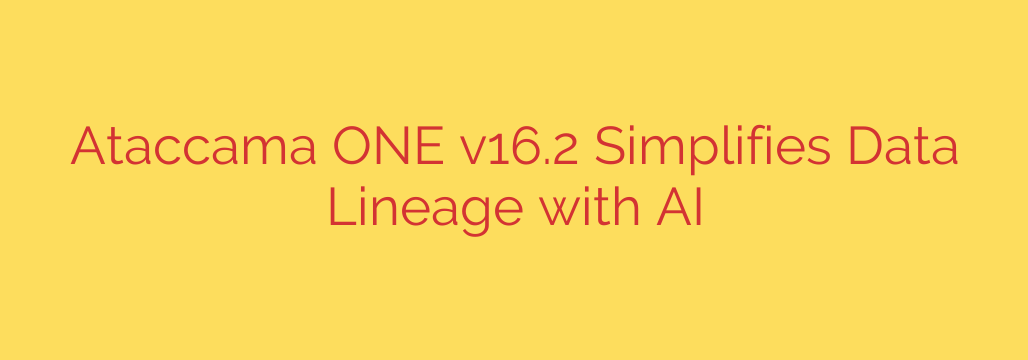
The Future of Data Governance: How AI is Revolutionizing Data Lineage
In today’s data-driven world, trust is everything. Business leaders rely on dashboards, analysts build models, and entire strategies are built on the assumption that the underlying data is accurate, compliant, and reliable. But how can you be certain? The answer lies in data lineage.
Data lineage is the story of your data—where it came from, how it has been transformed, and where it’s going. It provides a complete, auditable trail that is essential for everything from regulatory compliance to debugging a faulty report. However, creating and maintaining this trail has historically been a monumental task, often manual, error-prone, and so time-consuming that it becomes obsolete almost as soon as it’s completed.
Fortunately, a new era of data management is dawning, powered by artificial intelligence. AI is transforming this complex process from a manual burden into an automated, intelligent function that builds trust and accelerates insight.
The High Stakes of Incomplete Data Lineage
Without a clear view of your data’s journey, you’re operating in the dark. The consequences can be severe:
- Failed Audits and Compliance Risks: Regulations like GDPR and CCPA demand that organizations know exactly where sensitive customer data is stored and how it’s used. A lack of lineage makes this nearly impossible, exposing the business to heavy fines.
- Poor Decision-Making: If a key metric on a C-level dashboard is incorrect, how long would it take you to find the source of the error? Without lineage, this becomes a forensic nightmare, eroding trust in all business intelligence.
- Stifled Innovation: Data scientists and analysts waste countless hours trying to find and validate data sources instead of building models and driving insights.
The Old Way: Why Manual Lineage No Longer Works
Traditionally, data lineage was a painstaking process of manually stitching together information. Data engineers would have to dig through complex SQL scripts, ETL jobs, and documentation from dozens of different systems.
This approach is fundamentally broken in the modern data stack. It’s too slow, requires highly specialized expertise, and can’t keep up with the pace of change. A single modification to a data pipeline or report could render the entire lineage map inaccurate, leaving data teams back at square one.
A Smarter Path Forward: The Rise of AI-Powered Automation
Modern data platforms are now leveraging AI to completely automate the discovery and mapping of data lineage. By intelligently scanning metadata and code across your entire data ecosystem—from databases like Snowflake and Databricks to BI tools like Tableau and Power BI—these systems can piece together the data story for you.
Here’s how this new approach is a game-changer:
Automated, End-to-End Discovery: AI algorithms can automatically parse complex SQL code, Python scripts, and other data transformation logic. This allows them to connect the dots across disparate systems and build a comprehensive, end-to-end lineage map without tedious manual intervention.
Deep, Column-Level Granularity: True visibility requires more than just knowing a table was loaded. Advanced platforms now provide column-level lineage, tracking the journey of individual data fields from their origin in a source system all the way to a specific column in a final report. This is critical for precise impact analysis and root cause analysis.
Bridging the Gap Between IT and Business: Technical lineage, with its complex code and server names, is often meaningless to business users. AI-powered tools can translate this technical map into a simplified, business-friendly view. This allows a marketing manager, for example, to see exactly which data sources feed their campaign performance dashboard, building their confidence in the numbers.
Living, Breathing Lineage: Unlike a static map, an AI-generated lineage is dynamic. It continuously updates as your data pipelines and systems change, ensuring your understanding of your data flows is always current and accurate.
Actionable Security Tip: Use Lineage to Protect Sensitive Data
Automated data lineage is not just for data quality; it’s a powerful security tool. By tracking the flow of Personally Identifiable Information (PII) or other sensitive data categories, you can instantly see every report, database, and user that has access to it.
Actionable Step: Configure your data governance platform to automatically tag columns containing sensitive data (e.g., “email,” “ssn,” “address”). Use the lineage view to proactively identify potential security risks, such as sensitive data flowing into an insecure environment or being used in a non-compliant report. This allows you to enforce security policies and prevent data breaches before they happen.
Building a Foundation of Trust
The shift from manual to automated data lineage is more than just an efficiency gain; it’s a fundamental step toward building a true data-driven culture. When you can instantly perform root cause analysis on a flawed metric or confidently assess the impact of a planned data change, you empower your entire organization.
By embracing AI to automate this critical governance function, businesses can finally move past the challenges of data mistrust and unlock the full value of their data assets.
Source: https://datacenternews.asia/story/ataccama-one-v16-2-uses-ai-to-simplify-data-lineage-for-business








